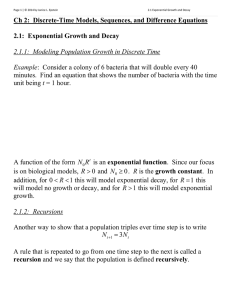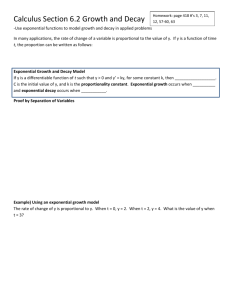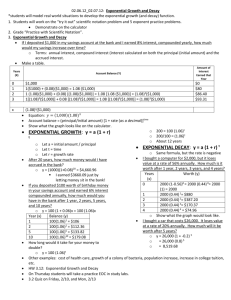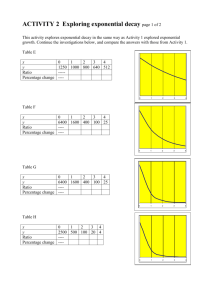Electronic Journal of Differential Equations, Vol. 2004(2004), No. 88, pp.... ISSN: 1072-6691. URL: or
advertisement
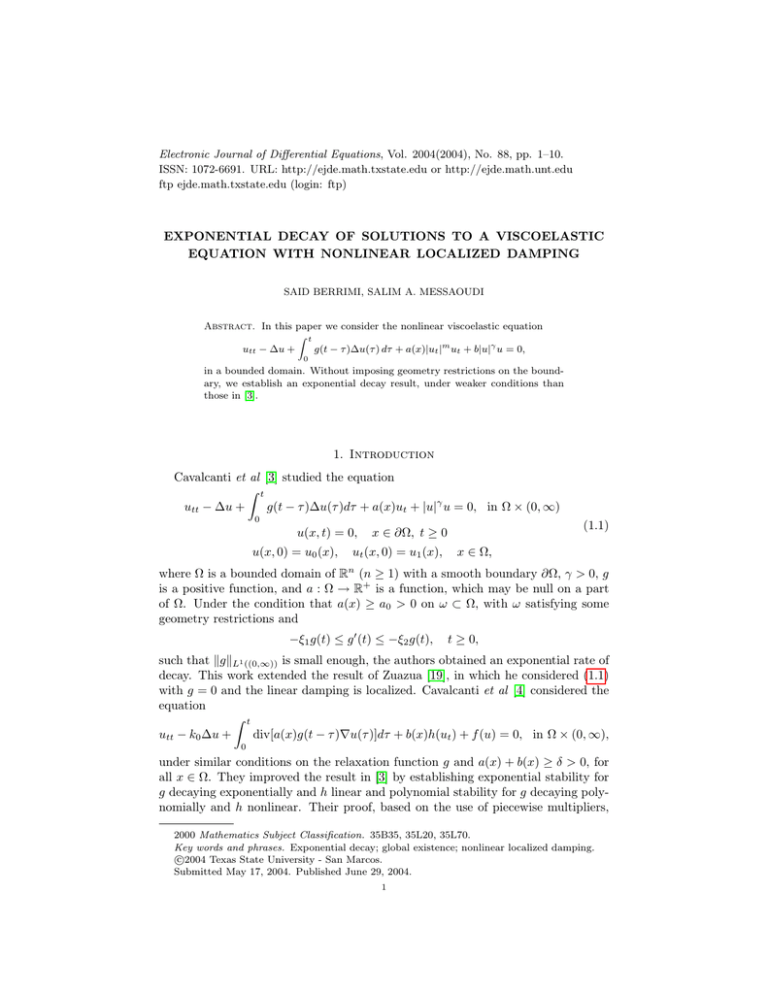
Electronic Journal of Differential Equations, Vol. 2004(2004), No. 88, pp. 1–10.
ISSN: 1072-6691. URL: http://ejde.math.txstate.edu or http://ejde.math.unt.edu
ftp ejde.math.txstate.edu (login: ftp)
EXPONENTIAL DECAY OF SOLUTIONS TO A VISCOELASTIC
EQUATION WITH NONLINEAR LOCALIZED DAMPING
SAID BERRIMI, SALIM A. MESSAOUDI
Abstract. In this paper we consider the nonlinear viscoelastic equation
Z t
utt − ∆u +
g(t − τ )∆u(τ ) dτ + a(x)|ut |m ut + b|u|γ u = 0,
0
in a bounded domain. Without imposing geometry restrictions on the boundary, we establish an exponential decay result, under weaker conditions than
those in [3].
1. Introduction
Cavalcanti et al [3] studied the equation
Z t
utt − ∆u +
g(t − τ )∆u(τ )dτ + a(x)ut + |u|γ u = 0, in Ω × (0, ∞)
0
u(x, t) = 0,
u(x, 0) = u0 (x),
(1.1)
x ∈ ∂Ω, t ≥ 0
ut (x, 0) = u1 (x),
x ∈ Ω,
where Ω is a bounded domain of Rn (n ≥ 1) with a smooth boundary ∂Ω, γ > 0, g
is a positive function, and a : Ω → R+ is a function, which may be null on a part
of Ω. Under the condition that a(x) ≥ a0 > 0 on ω ⊂ Ω, with ω satisfying some
geometry restrictions and
−ξ1 g(t) ≤ g 0 (t) ≤ −ξ2 g(t),
t ≥ 0,
such that kgkL1 ((0,∞)) is small enough, the authors obtained an exponential rate of
decay. This work extended the result of Zuazua [19], in which he considered (1.1)
with g = 0 and the linear damping is localized. Cavalcanti et al [4] considered the
equation
Z t
utt − k0 ∆u +
div[a(x)g(t − τ )∇u(τ )]dτ + b(x)h(ut ) + f (u) = 0, in Ω × (0, ∞),
0
under similar conditions on the relaxation function g and a(x) + b(x) ≥ δ > 0, for
all x ∈ Ω. They improved the result in [3] by establishing exponential stability for
g decaying exponentially and h linear and polynomial stability for g decaying polynomially and h nonlinear. Their proof, based on the use of piecewise multipliers,
2000 Mathematics Subject Classification. 35B35, 35L20, 35L70.
Key words and phrases. Exponential decay; global existence; nonlinear localized damping.
c
2004
Texas State University - San Marcos.
Submitted May 17, 2004. Published June 29, 2004.
1
2
S. BERRIMI, S. A. MESSAOUDI
EJDE-2004/88
is similar to the one in [3]. Another problem, where the damping induced by the
viscosity is acting on the domain and a part of the boundary, was also discussed by
Cavalcanti et al [5] and existence and uniform decay rate results were established.
In the same direction, Cavalcanti et al [2] have also studied, in a bounded domain,
the equation
t
Z
ρ
|ut | utt − ∆u − ∆utt +
g(t − τ )∆u(τ )dτ − γ∆ut = 0,
0
with x ∈ Ω, t > 0, ρ > 0. They proved a global existence result for γ ≥ 0 and
an exponential decay for γ > 0. This last result has been extended to a situation,
where a source term is competing with the strong damping mechanism and the one
induced by the viscosity, by Messaoudi and Tatar [16]. There, the authors combined
well known methods with perturbation techniques to show that a solution with
positive but small energy exist globally and decay to the rest state exponentially.
Messaoudi [17] considered the equation
Z
utt − ∆u +
t
g(t − τ )∆u(τ )dτ + aut |ut |m = b|u|γ u,
in Ω × (0, ∞)
0
and showed, under suitable conditions on g, that solutions with negative energy
blow up in finite time if γ > m, and continue to exist if m ≥ γ. We also should
mention the work of Kavashima and Shibata [9], in which a global existence and
exponential stability of small solutions to a nonlinear viscoelastic problem has been
established.
In the absence of the viscoelastic term (g = 0), the problem has been extensively
studied and many results concerning global existence and nonexistence have been
proved. For instance, for the problem
utt − ∆u + aut |ut |m = b|u|γ u,
u(x, t) = 0,
u(x, 0) = u0 (x),
in Ω × (0, ∞)
x ∈ ∂Ω, t ≥ 0
ut (x, 0) = u1 (x),
(1.2)
x ∈ Ω,
with m, γ ≥ 0, it is well known that, for a = 0, the source term bu|u|γ , (γ > 0)
causes finite time blow up of solutions with negative initial energy (see [1, 8]) and
for b = 0, the damping term aut |ut |m assures global existence for arbitrary initial
data (see [7, 10]). The interaction between the damping and the source terms
was first considered by Levine [11, 12] in the linear damping case (m = 0). He
showed that solutions with negative initial energy blow up in finite time. Georgiev
and Todorova [6] extended Levine’s result to the nonlinear damping case (m > 0).
In their work, the authors introduced a different method and determined suitable
relations between m and γ, for which there is global existence or alternatively finite
time blow up. Precisely; they showed that solutions with negative energy continue
to exist globally ’in time’ if m ≥ γ and blow up in finite time if γ > m and the
initial energy is sufficiently negative. Without imposing the condition that the
initial energy is sufficiently negative, Messaoudi [15] extended the blow up result
of [6] to solutions with negative initial energy only. For results of same nature, we
refer the reader to Levine and Serrin [13] and Levine and Park [14], Vitillaro [18].
EJDE-2004/88
EXPONENTIAL DECAY OF SOLUTIONS
In the present work, we are concerned with
Z t
utt − ∆u +
g(t − τ )∆u(τ )dτ + a(x)ut |ut |m + |u|γ u = 0,
in Ω × (0, ∞)
0
u(x, t) = 0,
u(x, 0) = u0 (x),
(1.3)
x ∈ ∂Ω, t ≥ 0
ut (x, 0) = u1 (x),
3
x ∈ Ω,
for m ≥ 0. We will prove an exponential decay result under weaker conditions on
both a and g. In fact we will allow a to vanish on any part of Ω (including Ω itself).
As a consequence, the geometry restriction imposed on a part of ∂Ω by Cavalcanti
et al [3] is dropped. Although this present work and [4] both improve [3], they have
different nature and use different approaches. Our method of proof is based on
the use of the perturbed energy technique. Our choice of the Lyaponov functional
made our proof easier than the one in [3, 4]. This paper is organized as follows.
In Section 2, We present some notation and material needed for our work and we
state the global existence theorem in [3]. Section 3 contains the statement and the
proof of our main result.
2. Preliminaries
In this section, we shall prepare some material needed in the proof of our result
and state, without proof, a global existence result, which may be proved by repeating the argument of [3]. We use the standard Lebesgue space Lp (Ω) and Sobolev
space H01 (Ω) with their usual scalar products and norms. The symbols ∇ and ∆
will stand for the gradient and the Laplacian respectively and the subscript t will
denote the time differentiation.
For the relaxation function g(t) we assume
(G1) g : R+ → R+ is a bounded C 1 function such that g(0) > 0 and
Z ∞
1−
g(s)ds = l > 0.
0
(G2) There exists a positive constant ξ such that g 0 (t) ≤ −ξg(t), for t ≥ 0.
Proposition 2.1. Let (u0 , u1 ) ∈ H01 (Ω) × L2 (Ω). Assume that g satisfies (G1) and
2
, n≥3
n−2
γ ≥ 0, n = 1, 2 .
0≤γ≤
(2.1)
Then problem (1.3) has a unique global solution,
u ∈ C([0,
ut ∈ C([0,
∞); H01 (Ω))
∞); L2 (Ω)) ∩ Lm+2
(Ω × (0,
a
∞)),
(2.2)
where Lm+2
is the weighted Lebesgue space.
a
Remark 2.2. Condition (2.1) is needed so that the nonlinearity is Lipschitz from
H 1 (Ω) to L2 (Ω). Condition (G1) is necessary to guarantee the hyperbolicity of the
system (1.3).
Now, we introduce the energy
Z t
1
1
1
1
E(t) :=
1−
g(s)ds k∇u(t)k22 + kut k22 + (g ◦ ∇u)(t) +
kukγ+2
γ+2 , (2.3)
2
2
2
γ
+
2
0
4
S. BERRIMI, S. A. MESSAOUDI
where
Z
(g ◦ v)(t) =
EJDE-2004/88
t
g(t − τ )kv(t) − v(τ )k22 dτ.
(2.4)
0
Remark 2.3. Multiplying equation (1.3) by ut and integrating over Ω, then using
integration by parts and hypotheses (G1) and (G2), we obtain, after some manipulations,
Z
1
1
0
E (t) ≤ −
a(x)|ut |m+2 dx − (g 0 ◦ ∇u)(t) + g(t)k∇u(t)k2
2
2
Z Ω
(2.5)
1
0
m+2
≤−
a(x)|ut |
dx + (g ◦ ∇u)(t) ≤ 0.
2
Ω
This implies that “modified” energy is uniformly bounded (by E(0)) and is decreasing in t.
We will also use the embedding H01 (Ω) ,→ Lq (Ω) for 2 ≤ q ≤ 2n/(n − 2) if
n ≥ 3 or q ≥ 2 if n = 1, 2 and Lr (Ω) ,→ Lq (Ω), for q < r. We will use the same
embedding constant denoted by Cp ; i.e.
kvkq ≤ Cp k∇vk2 ,
kvkq ≤ Cp kvkr .
(2.6)
3. Exponential decay
Before we state and prove our main result, we prove the following lemma.
Lemma 3.1. Let m ≤ 2/(n − 2), for n ≥ 3. Then there exists a constant C
depending on Cp , kak∞ , E(0), and m only, such that the solution (2.2) satisfies
Z
a(x)|u|m+2 dx ≤ C k∇uk22 + kukγ+2
(3.1)
γ+2
Ω
Proof. If m ≤ γ then we have two cases either kukm+2 ≤ 1, in which case
Z
2
2
2
a(x)|u|m+2 dx ≤ kak∞ kukm+2
m+2 ≤ kak∞ kukm+2 ≤ Cp kak∞ k∇uk2 ;
(3.2)
Ω
or kukm+2 > 1, in which case
Z
γ+2
γ+2
a(x)|u|m+2 dx ≤ kak∞ kukm+2
kak∞ kukγ+2
m+2 ≤ kak∞ kukm+2 ≤ Cp
γ+2 .
(3.3)
Ω
If m > γ then
Z
2E(t) m/2
a(x)|u|m+2 dx ≤ Cpm+2 kak∞ k∇ukm+2
≤ Cpm+2 kak∞ k∇uk22
2
l
Ω
2E(0)
m/2
≤ Cpm+2 kak∞
k∇uk22
l
Combining (3.2), (3.3) with the above inequality, we complete the proof.
Theorem 3.2. Let (u0 , u1 ) ∈ H01 (Ω) × L2 (Ω). Assume that g satisfies (G1) and
(G2), such that
2
0 ≤ max{m, γ} ≤
, n ≥ 3.
n−2
Then there exist positive constants k and K, such that the solution given by (2.2)
satisfies E(t) ≤ Ke−kt for all t ≥ 0.
EJDE-2004/88
EXPONENTIAL DECAY OF SOLUTIONS
5
Proof. We define the function
F (t) := E(t) + ε1 Ψ(t) + ε2 χ(t)
(3.4)
where ε1 and ε2 are positive constants to be specified later and
Z
Ψ(t) :=
uut dx
Ω
Z
Z t
χ(t) := −
ut
g(t − τ )(u(t) − u(τ ))dτ dx .
Ω
0
It is straightforward to see that for ε1 and ε2 small, we have
α1 F (t) ≤ E(t) ≤ α2 F (t),
holds for two positive constants α1 and α2 . In fact
Z
Z
2
F (t) ≤ E(t) + (ε1 /2)
|ut | dx + (ε1 /2)
|u|2 dx
Ω
Ω
Z
Z Z t
2
2
+ (ε2 /2)
|ut | dx + (ε2 /2)
g(t − τ )(u(t) − u(τ ))dτ dx
Ω
Ω
0
Z
Z
2
≤ E(t) + (ε1 /2)
|ut | dx + (ε1 /2)Cp
|∇u|2 dx
Ω
Ω
Z
2
+ (ε2 /2)
|ut | dx + (ε2 /2)Cp (1 − l)(g ◦ ∇u)(t)
(3.5)
(3.6)
Ω
1
E(t)
≤
α1
where E(t) is the energy, and
Z
Z
2
F (t) ≥ E(t) − (ε1 /2)
|ut | dx − (ε1 /2)
|u|2 dx
Ω
Ω
Z
− (ε2 /2)
|ut |2 dx − (ε2 /2)Cp (1 − l)(g ◦ ∇u)(t)
Ω
1
1
1
1
kukγ+2
≥ lk∇u(t)k22 + kut k22 + (g ◦ ∇u)(t) +
γ+2
2
2
2
γ+2
Z
Z
ε 1 + ε2
ε1
ε2
−
|ut |2 dx − ( )Cp
|∇u|2 dx − ( )Cp (1 − l)(g ◦ ∇u)(t)
2
2
2
Ω
Ω
1
≥
E(t)
α1
for ε1 and ε2 small enough. Using equation (1.3), we easily see that
Z
Ψ0 (t) = (uutt + u2t )dx
Ω
Z
Z
Z
Z t
=
u2t dx −
|∇u|2 dx +
∇u(t)
g(t − τ )∇u(τ )dτ dx
Ω
Ω
Ω
0
Z
Z
−
|u|γ+2 dx −
a(x)|ut |m ut udx
Ω
Ω
We now estimate the third term in the right-hand side of (3.7) as follows:
Z
Z t
∇u(t).
g(t − τ )∇u(τ )dτ dx
Ω
0
(3.7)
6
S. BERRIMI, S. A. MESSAOUDI
EJDE-2004/88
Z Z t
2
1
g(t − τ )|∇u(τ )|dτ dx
2 Ω
0
Z Z t
2
1
g(t − τ )(|∇u(τ ) − ∇u(t)| + |∇u(t)|)dτ dx .
2 Ω
0
Rt
R∞
Using Cauchy-Schwarz and Young’s inequality, and 0 g(τ )dτ ≤ 0 g(τ )dτ = 1 − l,
we obtain that for any η > 0,
Z Z t
2
g(t − τ )(|∇u(τ ) − ∇u(t)| + |∇u(t)|)dτ dx
Ω
0
Z Z t
Z Z t
2
2
≤
g(t − τ )(|∇u(τ ) − ∇u(t)|dτ dx +
g(t − τ )|∇u(t)|dτ dx
Ω
0
Ω
0
Z Z t
Z t
+2
g(t − τ )(|∇u(τ ) − ∇u(t)|dτ
g(t − τ )|∇u(t)|dτ dx
Ω
0
0
Z Z t
2
≤ (1 + η)
g(t − τ )|∇u(t)|dτ dx
Ω
0
Z Z t
2
1
+ (1 + )
g(t − τ )(|∇u(τ ) − ∇u(t)|dτ dx
η Ω
0
Z Z t
Z t
1
≤ (1 + )
g(t − τ )dτ
g(t − τ )|∇u(τ ) − ∇u(t)|2 dτ dx
η Ω 0
0
Z
Z t
2
+ (1 + η)
|∇u(t)|2
g(t − τ )dτ dx
Ω
0
Z
≤ (1 + η)(1 − l)2
|∇u(t)|2 dx
Ω
Z Z t
1
+ (1 + )(1 − l)
g(t − τ )|∇u(τ ) − ∇u(t)|2 dτ dx .
η
Ω 0
Z
1
|∇u(t)|2 dx +
2 Ω
Z
1
≤
|∇u(t)|2 dx +
2 Ω
≤
For the fifth term of the right-hand side of (3.7), we use Young’s inequality and
Lemma 3.1 to get
Z
Z
Z
m
m+2
a(x)|ut | ut udx ≤ δ
a(x)|u|
dx + c(δ)
a(x)|ut |m+2 dx
Ω
Ω
Ω
Z
(3.8)
≤ c(δ)
a(x)|ut |m+2 dx + δC{k∇uk22 + kukγ+2
}
γ+2
Ω
By combining (3.7)–(3.8), we have
Ψ0 (t)
Z
Z
Z
Z
1
|∇u(t)|2 dx
≤
u2t dx −
|∇u|2 dx −
|u|γ+2 dx +
2
Ω
Ω
Ω
Z
Z Ω
1
2
2
+ (1 + η)(1 − l)
|∇u(t)| dx + c(δ)
a(x)|ut |m+2 dx + δCp k∇uk22
2
Ω
Ω
Z Z t
1
1
+ δCp kukγ+2
}
+
(1
+
)(1
−
l)
g(t − τ )|∇u(τ ) − ∇u(t)|2 dτ dx
γ+2
2
η
Ω 0
Z
Z
Z
Z
1
2
2
2
γ+2
≤
ut dx −
|∇u| dx −
|u|
dx + [1 + (1 + η)(1 − l) ]
|∇u(t)|2 dx
2
Ω
Ω
Ω
Ω
EJDE-2004/88
EXPONENTIAL DECAY OF SOLUTIONS
1
1
+ (1 + )(1 − l)(g ◦ ∇u)(t) + c(δ)
2
η
Z
7
a(x)|ut |m+2 dx + δC{k∇uk22 + kukγ+2
γ+2 }
Ω
By choosing η = l/(1 − l) and δ = l /4C, the above inequality becomes
Z
Z
Z
l
4−l
1−l
2
0
2
|∇u| dx −
|u|γ+2 dx +
(g ◦ ∇u)(t)
Ψ (t) ≤
ut dx −
4 Ω
4
2l
Ω
Ω
Z
+ c(δ)
a(x)|ut |m+2 dx.
(3.9)
Ω
Next we estimate
Z
Z t
χ0 (t) = −
utt
g(t − τ )(u(t) − u(τ ))dτ dx
Ω
0
Z
Z t
Z t
Z
−
ut
g 0 (t − τ )(u(t) − u(τ ))dτ dx − (
g(s)ds)
u2t dx
Ω
0
0
Ω
Z
Z t
=
∇u(t).(
g(t − τ )(∇u(t) − ∇u(τ ))dτ )dx
Ω
0
Z Z t
Z t
− (
g(t − τ )∇u(τ )dτ ).(
g(t − τ )(∇u(t) − ∇u(τ ))dτ )dx
Ω 0
0
Z
Z t
+
a(x)ut (t)
g(t − τ )(u(t) − u(τ ))dτ dx
Ω
0
Z
Z t
γ
+
|u| u
g(t − τ )(u(t) − u(τ ))dτ dx
Ω
0
Z
Z t
Z t
Z
0
−
ut
g (t − τ )(u(t) − u(τ ))dτ dx − (
g(s)ds)
u2t dx
Ω
0
0
(3.10)
Ω
Similarly to (3.7), we estimates the right-hand side terms of the above inequality.
So for δ > 0, we have: For the first term,
Z
Z t
Z
1−l
(g ◦ ∇u)(t).
−
∇u(t).(
g(t − τ )(∇u(t) − ∇u(τ ))dτ )dx ≤ δ
|∇u|2 dx +
4δ
Ω
0
Ω
(3.11)
For the second term,
Z Z t
Z t
g(t − s)∇u(s)ds
g(t − s)(∇u(t) − ∇u(s))ds dx
Ω
0
0
Z Z t
Z Z t
2
2
1
≤δ
g(t − s)∇u(s)ds dx +
g(t − s)(∇u(t) − ∇u(s))ds dx
4δ Ω 0
Ω
0
Z Z t
2
≤δ
g(t − s)(|∇u(t) − ∇u(s)| + |∇u(t)|)ds dx
Ω
0
Z t
Z Z t
1
+ (
g(t − s)ds)
g(t − s)|∇u(t) − ∇u(s)|2 ds dx .
4δ 0
Ω 0
Z Z t
2
≤δ
g(t − s)|∇u(t) − ∇u(s)|ds dx
Ω
0
Z
1
+ 2δ(1 − l)2
|∇u|2 dx + (1 − l)(g ◦ ∇u)(t)
4δ
Ω
Z
1
2
≤ (2δ + )(1 − l)(g ◦ ∇u)(t) + 2δ(1 − l)
|∇u|2 dx .
4δ
Ω
8
S. BERRIMI, S. A. MESSAOUDI
EJDE-2004/88
For the third term,
Z
Z t
Z
Cp (1 − l)
a(x)ut (t)
g(t − τ )(u(t) − u(τ ))dτ dx ≤ δkak∞
u2t dx +
(g ◦ ∇u)(t).
4δ
Ω
0
Ω
For the fourth term,
Z
Z t
|u|γ u
g(t − τ )(u(t) − u(τ ))dτ dx
Ω
0
Z Z t
Z
2
1
2(γ+1)
g(t − τ )(u(t) − u(τ ))dτ dx
≤δ
|u|
dx +
4δ Ω
0
Ω
We use (2.1) (2.3) and (2.5) to obtain
Z
E(0) 2γ
2(γ+1)
|u|2(γ+1) dx ≤ Cp k∇uk2
≤ Cp (
) k∇uk22
l
Ω
(3.12)
(3.13)
By inserting (3.13) in (3.12), we get
Z
Z t
E(0) 2γ
Cp (1 − l)
|u|γ u
g(t − τ )(u(t) − u(τ ))dτ dx ≤ δCp (
) k∇uk22 +
(g ◦ ∇u)(t) .
l
4δ
Ω
0
For the fifth term,
Z
Z t
−
ut
g 0 (t − τ )(u(t) − u(τ ))dτ dx
Ω
0
Z
Z Z t
0
g(0)
Cp
−g (t − s)|∇u(t) − ∇u(s)|2 ds dx .
≤δ
|ut |2 dx +
4δ
Ω 0
Ω
(3.14)
Combining (3.10)–(3.14) yields
χ0 (t)
1 − l
E(0) 2γ
Cp (1 − l) ) }k∇uk22
+ 2δ(1 − l) +
(g ◦ ∇u)(t)
l
2δ
2δ
Z t
Z
g(0)
Cp (−(g 0 ◦ ∇u)(t)) + δ(1 + kak∞ ) −
g(s)ds
u2t dx .
+
4δ
0
Ω
(3.15)
Since g(0) > 0 then there exists t0 > 0 such that
Z t
Z t0
g(s)ds ≥
g(s)ds = g0 > 0, ∀t ≥ t0 .
(3.16)
≤ δ{1 + 2(1 − l)2 + Cp (
0
0
Using (3.4), (3.9), (3.15), and (3.16), we obtain
F 0 (t)
Z
a(x)|ut |m+2 dx
Z
Z
4−l
2
− ε2 {g0 − δ(1 + kak∞ )} − ε1
ut dx − ε1
|u|γ+2 dx
4
Ω
Ω
ε1 l
E(0) 2γ −
− ε2 δ{1 + 2(1 − l)2 + Cp (
) } k∇uk22
4
l
1 ε1 (1 − l)
g(0)
(1 − l)Cp
1 − l 2δ(1 − l) 0
+
−
− ε2 {
Cp +
+
+
} (g ◦ ∇u)(t).
2
2ξl
4δ
2δξ
2δξ
ξ
≤ −(1 − ε1 c(δ))
Ω
EJDE-2004/88
EXPONENTIAL DECAY OF SOLUTIONS
9
Now, we choose δ so small that
g0 − δ(1 + kak∞ ) >
1
g0
2
4
E(0) 2γ
1
δ{1 + 2(1 − l)2 + Cp (
) } < g0 .
l
l
4
Whence δ is fixed, the choice of any two positive constants ε1 and ε2 satisfying
1
1
g0 ε2 < ε1 < g0 ε2
(3.17)
4
2
will make
k1 = ε2 {g0 − δ(1 + kak∞ )} − ε1 > 0
ε1 l
E(0) 2γ
− ε2 δ{1 + 2(1 − l)2 + Cp (
) } > 0.
4
l
We then pick ε1 and ε2 so small that (3.5) and (3.17) remain valid and
k2 =
1 − ε1 c(δ) > 0,
g(0)
(1 − l)Cp
1 − l 2δ(1 − l)
1 ε1 (1 − l)
−
− ε2 {
Cp +
+
+
}>0
2
2ξl
4δ
2δξ
2δξ
ξ
Therefore, we arrive at F 0 (t) ≤ −βE(t) for all t ≥ t0 . This inequality and (3.5)
yield F 0 (t) ≤ −βα1 F (t), for all t ≥ t0 . A simple integration leads to
F (t) ≤ F (t0 )eβα1 t0 e−βα1 t ,
∀t ≥ t0 .
This inequality and (3.5) yields
E(t) ≤ α2 F (t0 )eβα1 t0 e−βα1 t ,
which completes the proof.
∀t ≥ t0 ,
Remark 3.3. Note that our result is proved without imposing any restriction on
the size of kgkL1 . Also note that the function a may vanish on the whole domain
Ω. In other words, contrary to [3], measure (ω) can be zero. As a consequence, no
geometry restriction on the boundary has been assumed.
Acknowledgment. The authors would like to express their sincere thanks to King
Fahd University of Petroleum and Minerals for its support. This work has been
funded by KFUPM under Project # MS/VISCO ELASTIC/270.
References
[1] Ball J., Remarks on blow up and nonexistence theorems for nonlinear evolutions equations,
Quart. J. Math. Oxford 28 (1977), 473 - 486.
[2] Cavalcanti M. M., V. N. Domingos Cavalcanti and J. Ferreira; Existence and uniform decay
for nonlinear viscoelastic equation with strong damping, Math. Meth. Appl. Sci. 24 (2001),
1043 - 1053.
[3] Cavalcanti M. M., V. N. Domingos Cavalcanti and J. A. Soriano; Exponential decay for the
solution of semilinear viscoelastic wave equations with localized damping, Elect. J. Diff. Eqs.
Vol. 2002 (2002) 44, 1 - 14.
[4] Cacalcanti M. M. and Oquendo H. P.; Frictional versus viscoelastic damping in a semilinear
wave equation, SIAM J. Control Optim. vol 42 # 4 (2003), 1310 - 1324.
[5] Cavalcanti M. M., V. N. Domingos Cavalcanti, J. S. Prates Filho and J. A. Soriano; Existence
and uniform decay rates for viscoelastic problems with nonlinear boundary damping, Diff.
Integ. Eqs. 14 (2001) 1, 85 - 116.
[6] Georgiev, V. and G. Todorova, Existence of solutions of the wave equation with nonlinear
damping and source terms, J. Diff. Eqs. 109 (1994), 295 - 308.
10
S. BERRIMI, S. A. MESSAOUDI
EJDE-2004/88
[7] Haraux, A. and E. Zuazua, Decay estimates for some semilinear damped hyperbolic problems,
Arch. Rational Mech. Anal. 150 (1988), 191 - 206.
[8] Kalantarov V. K. and O. A. Ladyzhenskaya, The occurrence of collapse for quasilinear equations of parabolic and hyperbolic type, J. Soviet Math. 10 (1978), 53 -70.
[9] Kawashima S. and Shibata Y., Global Existence and exponential stability of small solutions
to nonlinear viscoelasticity, Comm. Math. Physics, Vol. 148 # 1(1992), 189 - 208.
[10] Kopackova M., Remarks on bounded solutions of a semilinear dissipative hyperbolic equation,
Comment. Math. Univ. Carolin. 30 (1989), 713 - 719.
[11] Levine, H. A., Instability and nonexistence of global solutions of nonlinear wave equation of
the form P utt = Au + F (u), Trans. Amer. Math. Soc. 192 (1974), 1 - 21.
[12] Levine H. A., Some additional remarks on the nonexistence of global solutions to nonlinear
wave equation, SIAM J. Math. Anal. 5 (1974), 138 - 146.
[13] Levine H. A. and J. Serrin, A global nonexistence theorem for quasilinear evolution equation
with dissipation, Arch. Rational Mech. Anal., 137 (1997), 341 - 361.
[14] Levine, H. A. and S. Ro Park, Global existence and global nonexistence of solutions of the
Cauchy problem for a nonlinearly damped wave equation, J. Math. Anal. Appl. 228 (1998),
181 - 205.
[15] Messaoudi S. A., Blow up in a nonlinearly damped wave equation, Mathematische
Nachrichten, 231 (2001), 1 - 7.
[16] Messaoudi S. A. and Tatar N-E., Global existence asymptotic behavior for a Nonlinear Viscoelastic Problem, Math. Meth. Sci. Research J., Vol. 7 # 4 (2003), 136-149.
[17] Messaoudi S. A., Blow up and global existence in a nonlinear viscoelastic wave equation,
Mathematische Nachrichten, vol. 260 (2003), 5 8 - 66.
[18] Vitillaro E., Global nonexistence theorems for a class of evolution equations with dissipation,
Arch. Rational Mech. Anal., 149 (1999), 155 - 182.
[19] Zuazua E., Exponential decay for the semilinear wave equation with locally distributed damping, Comm. PDE. 15 (1990), 205 - 235.
Said Berrimi
Math Department, University of Setif, Setif, Algeria
E-mail address: berrimi@yahoo.fr
Salim A. Messaoudi
Mathematical Sciences Department, KFUPM, Dhahran 31261, Saudi Arabia
E-mail address: messaoud@kfupm.edu.sa





